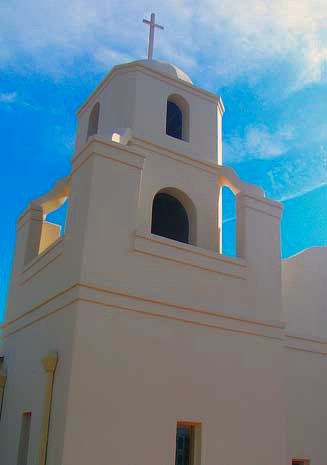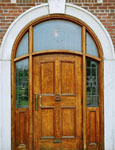Rishma Dunlop
Turquoise, Water and Sky

Old Adobe Mission, Old Town, Scottsdale
©Rishma Dunlop
She wore a turquoise sari, strolling past a restored Spanish colonial mission in Old Town. It surprised me; she was the first woman in a sari I had seen in Phoenix. The brilliant blue-green hue stayed with me all afternoon, as I wandered through the marketplace among tourists and found myself wanting something turquoise, the color the Egyptians believed to be faith and truth. So I bought a small turquoise stone from a Navajo vendor and kept it in my pocket. The vendor had told me that the Aztecs used to place turquoise in the mouths of the dead to feed the heart, and Native colleagues at the university had helped me recognize its mythic significance – turquoise anchors a corner of the four-cornered Navajo world; it guards desert springs and it is itself water and sky. It’s the stone that strengthens the eyes, the talisman that protects travelers against pain and demons in the desert. To protect yourself from lightning, say the Navajo, wear a bead of turquoise in your hair. I came to believe, like the Zuni, that turquoise is a form of stone-hard water. A gift of the desert, like a lover’s name carried blue in the throat.
Winter in Phoenix wore the stillness of the Sonoran desert. On days when I drove to Arizona State University, where I was Canada-US Research Chair in Creative Writing, I was constantly struck by names of streets: Superstition Freeway – Drinkwater Boulevard – Carefree. The highways are flanked by saguaro cacti and Navajo designs, representing the cycles of life and the weather. The sky is a wide-open blue over banks of reddish earth – shades of terra cotta, vermilion, veins of blood-red – a desert tempered by iron.
The Fulbright Award was a precious gift of time for me. My scholarly research and creative writing had always been juggled between family and professional demands. But now, after years of being a wife, a mother of two daughters, a Ph.D. student, a professor and administrator of the Creative Writing Program at York University in Toronto, I found myself surprised by the wave of creativity that the Fulbright afforded me. Writing, here in the desert, I drank the bone-dry air with an open mouth and words exploded my hands, my eyes, my past.
Faithfully, I woke up and wrote every morning in a small house I had rented on the crossroads between Lowell and Harmony. I was inspired to work on a volume of new and selected poems, as well as the novel I had been planning to write for many years. Late in the afternoons, I would go over my notes at spots like the architectural wonder of the Biltmore Hotel, or at Valley-Ho, the hotel bar once frequented by Hollywood starlets, or the lounge at the historic Royal Palms resort surrounded by stone walkways, fountains and gardens. I explored the grounds and archives at Taliesin West, Frank Lloyd Wright’s School of Architecture, doing background research for a character in my novel set in Arizona, British Columbia, New York and Paris.
Daily, the desert guided me into a calmness I applied to my writing. The silhouette of Camelback Mountain became the spine of the body through which I entered the exterior landscape to see the interior realm I was creating in my novel. At night, as the heat of the sun receded, the mesas were lit by the kind of moon that would remind me of children’s storybooks; yet, sometimes the night sky was velvet black, moonless, eye-blind and pitch dark.
Several times a week, I enjoyed supper and conversation with scholars like Rosalynn Voaden who teaches a popular course titled “Sex Death Snow: An Introduction to Canadian Literature” at ASU. My lecture and poetry reading to her class became the catalyst to a long compare-and-contrast discussion about the U.S. and Canada. Arizona’s immigration policy was sharply contrasted with the politics of diversity evident in the vast population of immigrants in my own city of Toronto, Canada. Yet, Arizona’s policies of sustainability and solar energy conservation struck me as forward thinking, a source of viable exchange of knowledge between the US and desert areas like the Okanagan Valley in Canada.
In the desert, demarcations are easily lost. Some nights, driving home, I felt that I was no longer only a Canadian; I was also an American, with a newly minted Social Insurance card, observing the differences that make a difference in our lives. Our shared geography across the Americas and Canada reminded me of the ways in which regional literatures, our fictions and non-fiction, teach us about the transparency and fluidity of border crossings. But the Sonoran also reminded me of the gift of grace we are given each time we touch a turquoise stone or drink a glass of water and recuperate in ourselves the incarnate sensorial experience of the living landscape in which we are embedded.
My Fulbright experience taught me to celebrate the spirit of resilience that is our shared continental awareness, and I will always remember the intensity of my impressions through the drumbeat of human emotions of grief, love and joy. But most of all, I will remember the Arizona landscape as a palpable force, the scent of orange blossoms, profuse and heady; the smell of diesel and tar on the highways; vast meadows of wildflowers, gold poppies and lupines, after the winter rains; and the astonishing saguaro cacti, green thorns pointing like fingers to the April sky, night-blooming, waxy white flowers spreading a fragrance of ripe melons through the desert air.
Back in Toronto, after my four month residency in Arizona, I often hold the small turquoise stone I bought in Old Town in my cupped hand. It returns me to the desert, a place of faith, where I swallowed words like water and sky.
Winter in Phoenix wore the stillness of the Sonoran desert. On days when I drove to Arizona State University, where I was Canada-US Research Chair in Creative Writing, I was constantly struck by names of streets: Superstition Freeway – Drinkwater Boulevard – Carefree. The highways are flanked by saguaro cacti and Navajo designs, representing the cycles of life and the weather. The sky is a wide-open blue over banks of reddish earth – shades of terra cotta, vermilion, veins of blood-red – a desert tempered by iron.
The Fulbright Award was a precious gift of time for me. My scholarly research and creative writing had always been juggled between family and professional demands. But now, after years of being a wife, a mother of two daughters, a Ph.D. student, a professor and administrator of the Creative Writing Program at York University in Toronto, I found myself surprised by the wave of creativity that the Fulbright afforded me. Writing, here in the desert, I drank the bone-dry air with an open mouth and words exploded my hands, my eyes, my past.
Faithfully, I woke up and wrote every morning in a small house I had rented on the crossroads between Lowell and Harmony. I was inspired to work on a volume of new and selected poems, as well as the novel I had been planning to write for many years. Late in the afternoons, I would go over my notes at spots like the architectural wonder of the Biltmore Hotel, or at Valley-Ho, the hotel bar once frequented by Hollywood starlets, or the lounge at the historic Royal Palms resort surrounded by stone walkways, fountains and gardens. I explored the grounds and archives at Taliesin West, Frank Lloyd Wright’s School of Architecture, doing background research for a character in my novel set in Arizona, British Columbia, New York and Paris.
Daily, the desert guided me into a calmness I applied to my writing. The silhouette of Camelback Mountain became the spine of the body through which I entered the exterior landscape to see the interior realm I was creating in my novel. At night, as the heat of the sun receded, the mesas were lit by the kind of moon that would remind me of children’s storybooks; yet, sometimes the night sky was velvet black, moonless, eye-blind and pitch dark.
Several times a week, I enjoyed supper and conversation with scholars like Rosalynn Voaden who teaches a popular course titled “Sex Death Snow: An Introduction to Canadian Literature” at ASU. My lecture and poetry reading to her class became the catalyst to a long compare-and-contrast discussion about the U.S. and Canada. Arizona’s immigration policy was sharply contrasted with the politics of diversity evident in the vast population of immigrants in my own city of Toronto, Canada. Yet, Arizona’s policies of sustainability and solar energy conservation struck me as forward thinking, a source of viable exchange of knowledge between the US and desert areas like the Okanagan Valley in Canada.
In the desert, demarcations are easily lost. Some nights, driving home, I felt that I was no longer only a Canadian; I was also an American, with a newly minted Social Insurance card, observing the differences that make a difference in our lives. Our shared geography across the Americas and Canada reminded me of the ways in which regional literatures, our fictions and non-fiction, teach us about the transparency and fluidity of border crossings. But the Sonoran also reminded me of the gift of grace we are given each time we touch a turquoise stone or drink a glass of water and recuperate in ourselves the incarnate sensorial experience of the living landscape in which we are embedded.
My Fulbright experience taught me to celebrate the spirit of resilience that is our shared continental awareness, and I will always remember the intensity of my impressions through the drumbeat of human emotions of grief, love and joy. But most of all, I will remember the Arizona landscape as a palpable force, the scent of orange blossoms, profuse and heady; the smell of diesel and tar on the highways; vast meadows of wildflowers, gold poppies and lupines, after the winter rains; and the astonishing saguaro cacti, green thorns pointing like fingers to the April sky, night-blooming, waxy white flowers spreading a fragrance of ripe melons through the desert air.
Back in Toronto, after my four month residency in Arizona, I often hold the small turquoise stone I bought in Old Town in my cupped hand. It returns me to the desert, a place of faith, where I swallowed words like water and sky.













